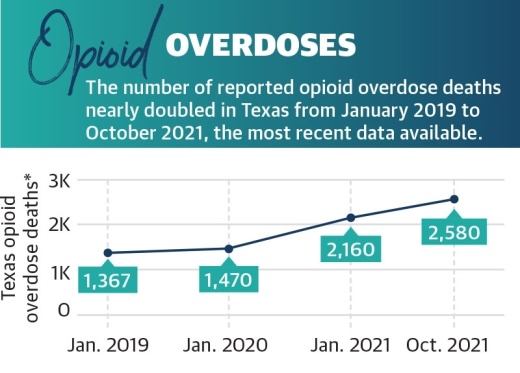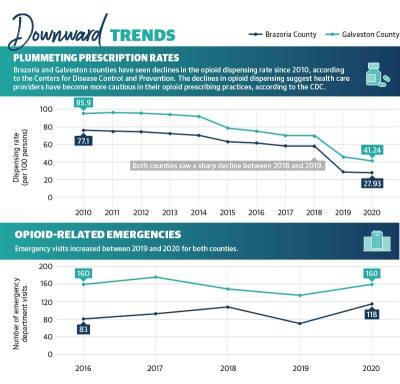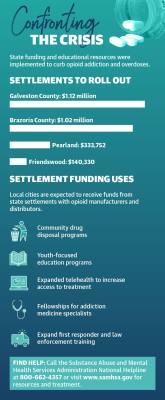Information from the Texas attorney general’s office indicates in 2020, drug overdose deaths had increased by around 32% from the previous year, driven primarily by opioids. Additionally, provisional data from the National Center for Health Statistics has shown reported opioid overdose deaths nearly doubled in Texas from January 2019 to January 2021, and there was an additional 30% increase in deaths from October 2020 to October 2021, the most recent data available.
“When people are economically challenged or psychologically challenged as many of us have been over the past two years, we see increased vulnerability in our communities to opioid use and other forms of substance misuse,” said Tyler Varisco, a health services researcher with the University of Houston.
With increased isolation and financial stresses, COVID-19 further exacerbated struggles against the opioid epidemic in Texas. Recovery treatment transitioned into less effective online services, and access to quality treatment became more complicated, according to local experts.
Opioid usage varies
In the late 1990s, pharmaceutical companies began marketing prescription opioid pain relievers as drugs that were not as addictive as previously thought, according to the National Institute on Drug Abuse. As a result, these drugs, which had formerly been prescribed only to treat acute pain, became the prescription of choice to treat chronic, long-term pain.
Les McColgin, a liaison for sobering center Houston Recovery Center who used opioids for 35 years, witnessed this change firsthand.
“Back in the late ’90s, you had the situation with Purdue Pharma and the new drug oxycontin ... and that whole situation where they were able to coerce the [Food and Drug Administration] into mislabeling the drug so it was presented as nonaddictive,” McColgin said.
In 2020, a little more than one prescription was issued on average for every four residents in Brazoria County with a little more than two prescriptions being issued for every five residents in Galveston County, based on Centers for Disease Control and Prevention data.
On the other hand, the dispensing rate declined sharply for both Brazoria and Galveston counties between 2018-19 and continued to slightly decrease in 2020. Despite declining dispensing rates countywide and across the state, reported opioid overdose deaths rose 25% from 2019-20 in Texas, per the NCHS. According to the CDC, synthetic opioids, such as fentanyl, have been one of the major driving forces in the rise of overdose deaths. One of the reasons for this, McColgin said, is fentanyl is unknowingly being put into other drugs and showing up in more overdoses and deaths than it had been previously.
“To be honest with you, I was never scared of anything. It didn’t matter; I wanted it as strong as I could get it. This scares me,” McColgin said.
Due to his experience, McColgin has conducted training for the Pearland Police Department and other similar entities on fentanyl and the use of Narcan, a nasal spray that can be administered during suspected overdoses.
Mary Beth Trevino, the Galveston County community coalition coordinator at addiction treatment center Bay Area Council on Drugs and Alcohol, agreed fentanyl is especially dangerous.
“Illegal-opioid addiction is a very big problem, especially fentanyl,” she said. “We have data to support that there has been a significant increase in fentanyl showing up [in Galveston and Harris counties].”
Pandemic effects on treatment
Varisco described several underlying causes of substance use disorders the pandemic has exacerbated, including patient access to treatment, increased financial stresses and isolation. Varisco said he believes the drastic changes to health care for individuals experiencing addiction undid recovery work performed for patients before the pandemic.
According to the Treatment Episode Data Set, which compiles national patient discharges from treatment for the Substance Abuse and Mental Health Services Administration, detoxification treatment discharges became less common from 2016-19, when detoxification discharges decreased from 20% of all discharges to 16%. However, the patient completion rate of detoxification treatment remained stable with fewer than half of patients completing treatment. “When you have a destabilizing event like a global pandemic, [vulnerabilities in health structures] become more evident,” Varisco said.
With in-person treatment at risk due to the coronavirus, health care centers went remote in 2020. Many centers were limited to offering substance use disorder care through telehealth services as opposed to in-person and personal programs, complicating opioid recovery for patients. Fenorris Pearson—the founder, president and CEO of Pursuit of Hope, a Pearland-based outpatient rehabilitation facility—said the pandemic has created difficulties for those seeking treatment.
“The pandemic affected our clients in a major way, and for some, it created a deeper state of depression, and it depleted their financial resources, which affects their ability to access the clinic on a consistent basis,” Pearson said. “If you think about what the pandemic has done, group health is a big part of what we do. We have not been able to do a lot of that.”
Despite being less effective, telehealth did allow some smaller clinics and private practices to expand their coverage areas. Lori Fiester, the clinical director at the Houston-based nonprofit Council on Recovery, said telehealth allowed patients without transportation access or those who are immunocompromised to receive care.
“We’ve had people across the state in our groups, including in the Austin area, which was really helpful for our groups to stay vital,” Fiester said.
At the beginning of the pandemic, Varisco said there was some confusion about what treatments were acceptable. A 2020 memo from Phil Wilson, the Texas Health and Human Services Commission executive commissioner, said buprenorphine could be prescribed virtually, but methadone required a face-to-face evaluation.
According to the SAMHSA, buprenorphine and methadone are FDA-approved drugs used in combination with counseling to treat opioid use disorders.
“I don’t know if [the policy] was well understood by providers, and that led to lapses in our treatment,” Varisco said.
Some barriers for treatment go beyond drug-related issues. Varisco and Pearson both agreed the lack of accessible public transportation in Texas increases the difficulty for lower-income patients.
“If you’re prescribed for buprenorphine or methadone or whatever, you have to take a bus across the city [of Houston] to get the prescription,” Varisco said. “Proximity to care is just not there.”
Government solutions
State and county entities are working to address the opioid epidemic and the effects the pandemic have on recovery through local funding, law enforcement resources and increased education surrounding opioid misuse. Many officials agreed the use of Narcan should be encouraged and used by emergency agencies.
Data for the usage of Narcan can be hard to track based on the different usages of it, such as when it is used for cardiac arrests, according to Pearland Police Department Officer Chad Rogers, who has undergone Narcan training. Despite this, it is a tool that is often shown in trainings.
“Obviously the overdoses are taking place, and we do what we can to save their lives,” Rogers said. “Narcan gives us that option and that opportunity to save that person’s life who may have taken a lethal dose of that narcotic.”
Statewide, Texas Attorney General Ken Paxton announced Feb. 16 that the state had secured a $1.17 billion settlement with major pharmaceutical companies. Pearland is set to receive $333,752 in settlement funding; Friendswood will receive $140,330; Brazoria County will receive around $1 million; and Galveston County will receive $1.1 million.
McColgin encouraged people to disregard any previous notions they might have about opioids.
“This idea that it’s only heroin addicts and hardcore drug addicts that are overdosing on this stuff has to be completely eliminated, or else we miss the most vulnerable people,” he said.
Ally Bolender and Jishnu Nair contributed to this report.







